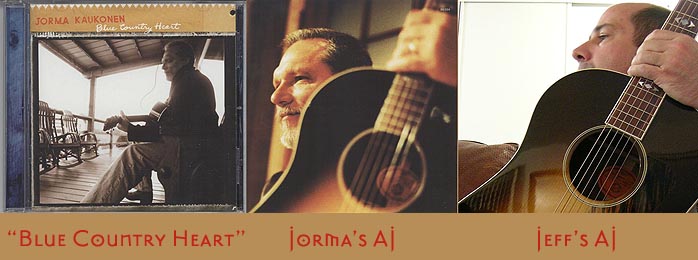 |
|
|
Apples and Oranges
I've had the good fortune to own or be able to try a number of excellent SET amplifiers in my HiFi rig. I've used SET amplifiers based on the 845 tube, the 300B tube, the 45 tube, the 2A3 tube and now the SEP (single-ended pentode) EL84 Almarro. The 300B driver interstage-coupled to the 845 output of my Cary 805C monos provided a gorgeously lush midrange and a billowing sense of space that was the sonic equivalent of Mrs. Richardson's hot fudge poured over Ben & Jerry's vanilla ice cream - a rich and creamy sonic taste treat. The 300B amplifiers by Audio Note and Art Audio I have tried had beautifully detailed midranges, powerful mid-bass and fire-side warmth that could be addictive - the audio equivalent of a steaming cup of good hot cocoa. The Wavelength Custom 45 monos that Gordon Rankin made for me some years ago were clean, refined, detailed and as clear and extended as a Montana summer sky. The brilliant little Almarro EL84 SEP has punchy pace and rhythm, is slightly dark and warm and has enough natural detail to keep your attention riveted on the music. I liked it so much I asked 6moons publisher Srajan to inquire of Mr. Yoshihiro Murmatsu san if I could purchase the review loaner. Guess what? I'm now the happy owner of the wonderful little Almarro.
A Monogamous Relationship
I've liked every one of the amplifiers I mentioned for their unique and differing charms and they all played music wonderfully well. The Fi 2A3s have punchy, deep and detailed bass flat to 20Hz with my Avantgarde Duos. They're brighter and more detailed than anything mentioned above with the exception of the Wavelength Custom 45. The Fi 2A3s have great pace, rhythm and timing bordering on Naim-like and an eminently engaging immediacy in the way they play music. They are a little rolled off on top compared to the Wavelength Custom 45 amplifiers but not in any way that bothers or troubles me. I think the Fi 2A3 breathes life into the music in such a fashion as to give me the feeling I'm listening to music hand- crafted by real people rather than a great recording - and they deliver the emotive message of the music with a knockout punch! I think the Fi 2A3s portray musical color better than any other SETs in my experience. Ideally I'd like to have amplifiers in my stable based on every output tube type just for the fun of it. Since that's not financially practical for me, I've cast my lot with the Fi 2A3s which combine a great deal of the best traits of all the tube types I've tried plus their own unique charms into a great pair of monaural SET tube amplifiers. It's what I want to come home to at night when I listen to my ol' HiFi rig.
|
|
 |
|
|
While listening the other night to Jorma Kaukonen play my Brazilian/Adirondack Gibson Custom Shop Advanced Jumbo acoustic flattop guitar on Blue Country Heart [Columbia CK86394] -- well, one just like mine anyways -- I realized that I've yet to meet an amplifier that captures the sound of a guitar as realistically as the Fi 2A3s. If you love acoustic guitar music like I do, look no further. The tone is right, the strings have the appropriate steel string zing and I hear a natural amount of finger movement along the windings of the E, A, D, and G strings just like in real life. Not only that but the notes project off the strings with a dynamic clarity and percussive forward drive that evokes the real thing - and that's no mean feat. The Fi 2A3 doesn't just give you a disembodied string sound either. You hear the contribution to the tone from the Brazilian rosewood and Adirondack spruce body of the guitar too.
|
|
 |
|
|
My first exposure to single-ended amplifiers occurred in 1997 at Déjà Vu Audio in MacLean/Virginia, while living in Arlington and working for Congress. The charismatic HiFi nut and owner of Déjà Vu Audio, Vu Hoang (the Vu in Déjà Vu), amazed me with the Fi 2A3 Stereo by playing the Royal Ballet Gala Performances [Classic Compact Discs LDSCD 6065] with Ernest Ansermet conducting. Every once in a while, I like to drag out Gala Performances and see how well present-day reality aligns with my memory of the aural astonishment I experienced on that fateful day in 1997. Starting at about 1 minute and 23 seconds into "Swan Lake", there are a series of right to left swings across the strings that should be electrifying and astonishing. The Fi 2A3 monos deliver maximum thrills and don't disappoint on the rest of the album either. |
|
|
|
 |
|
Don't like classical music? Try listening to it through the Fi 2A3s and you might change your mind. The strings are rosiny and grip me with their immediacy as they sweep across the soundstage. Bells sparkle and cymbals clang as the music swells and ebbs to produce a hypnotic musical effect. As soon as I am lulled into wistful reverie, I am startled out of my listening seat in an adrenaline-drenched rush by the sheer jump factor of the Fi 2A3s' excellent dynamics. The Fi 2A3s place each instrument in its unique position on a wide and deep soundstage with imaging that is eerily holographic to allow a mesmerizingly entertaining game of trying to identify the multitude of instruments present in all the nooks and crannies of the recording. Whew! That old Fi magic hasn't changed one bit.
|
|
|
 |
|
The Phillips 5V4GA versus the Phillips JAN 5Y3WGTA:
I suppose you're wondering how fiddling around with the tubes affects the Fi 2A3s. When you change from the Phillips ECG 5V4GA rectifiers to the Phillips ECG JAN 5Y3WGTAs, it changes the electrical characteristics by dropping the voltage to allow you to use either a 45 or 2A3. Changing the amps' rectifiers also changes the nature of their sound and music-playing ability.
|
|
|
With the Sovtek 2A3 tubes and the Phillips ECG 5V4GA rectifiers, when listening to Music for a Glass Bead Game [John Marks Records JMR 15] with Arturo Delmoni on violin and Nathaniel Rosen on cello, the sound's character was slightly dark, the texture of the bowed strings musically believable and Arturo's violin having just the right amount of bite, Nathaniel's cello the appropriate amount of growl. The 5V4GA sounds louder and more dynamic than the 5Y3WGTA and has a bigger and more colorful sound. The 5V4GA also exerts more impact in the bass and digs deeper in frequency, with a better sense of rhythmic drive. The 5Y3WGTA is a little more percussive with plucked notes, the leading edge of the notes being emphasized more while the 5V4GA lets the full bloom of the notes and overtones come through in a more musically natural fashion |
|
 |
|
The 5V4 has more of a sense of space in the recording and I hear the sounds of Nathaniel breathing and other little low- level details which I don't even notice with the 5Y3. The 5V4 is more musically engaging, drawing attention to the drama of the music. The 5Y3 is a little brighter sounding and gets a little shriller in the violin's higher notes to become a little more forward. With the 5Y3, you notice more of a note's first strike rather than its full bloom as with the 5V4. Bowed notes sound more rosiny with the 5Y3 -- perhaps more grainy -- as if they had more texture.
I guessed that the volume with the 5Y3 was down compared to the volume with the 5V4 but when I checked with a Realistic sound level meter (C weighting, slow response) using test tones from the Stereophile Test CD3 [Stereophile 006-2], the sound pressure levels proved to be exactly the same. There's no getting around it though - the 5V4GA sounds louder even though it isn't. The overall differences between the two rectifiers aren't huge but they're noticeable. The difference is more subtle however than the difference between a well-recorded CD like Glass Bead and, for example, the poorer sound quality of Lyle Lovett's Pontiac [MCA 42028].
|
|
|
Speaking of Lovett's Pontiac, its poorer sound quality was helped by the 5V4's more natural and full-bodied presentation of tone. The music drew me in less with the 5Y3. Its overall shriller nature put me off a bit by comparison. However, I could see how differences in the resultant sound of different HiFi rigs would better match the sound and presentation of the music with one rectifier over another. Having said all that, Don prefers the sound of the 5Y3WGTA in his system while I find the 5V4GA more pleasing in my system. You should probably try both and simply choose the one you like best.
|
|
|
|
 |
|
|
|
 |
 |
|
|
|
 |
|
|
|
|
|
|
|
|
|
|
|
|